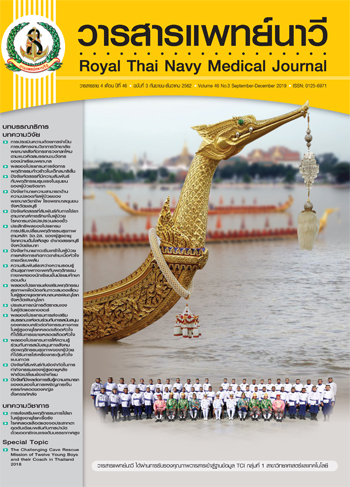ปัจจัยที่สัมพันธ์กับข้อจำกัดในการทำกิจกรรมของผู้สูงอายุหลังผ่าตัดเปลี่ยนข้อเข่าเทียม
Main Article Content
บทคัดย่อ
การวิจัยครั้งนี้เป็นการวิจัยเชิงบรรยายแบบหาความสัมพันธ์ มีวัตถุประสงค์เพื่อศึกษาความสัมพันธ์ระหว่างอายุ เพศ ดัชนีมวลกาย จำนวนโรคประจำตัว ความรุนแรงของอาการปวด ภาวะซึมเศร้า และการสนับสนุนทางสังคมกับข้อจำกัดในการทำกิจกรรมของผู้สูงอายุหลังผ่าตัดเปลี่ยนข้อเข่าเทียม กลุ่มตัวอย่าง คือ ผู้ที่มีอายุ 60 ปี ขึ้นไปทั้งเพศชายและเพศหญิง ได้รับการวินิจฉัยจากแพทย์ว่ามีภาวะข้อเข่าเสื่อมชนิดปฐมภูมิ (Primary osteoarthritis) และได้รับการผ่าตัดเปลี่ยนข้อเข่าเทียม ที่มาตรวจตามนัดในเดือนที่ 3 หลังผ่าตัด ณ ห้องตรวจโรคกระดูก แผนกผู้ป่วยนอก โรงพยาบาลสมเด็จพระปิ่นเกล้า โรงพยาบาลเลิดสิน และโรงพยาบาลตำรวจ จำนวน 120 คน ใช้การสุ่มแบบหลายขั้นตอนและคัดเลือกแบบเจาะจง โดยใช้แบบสอบถามข้อมูลส่วนบุคคล การประเมินดัชนีมวลกาย แบบประเมินความรุนแรงของอาการปวด แบบประเมินภาวะซึมเศร้าในผู้สูงอายุไทย แบบประเมินการสนับสนุนทางสังคม แบบประเมินข้อจำกัดในการทำกิจกรรมหลังผ่าตัดเปลี่ยนข้อเข่าเทียม สถิติที่ใช้วิเคราะห์ข้อมูล ได้แก่ ความถี่ ร้อยละ ค่าเฉลี่ย ส่วนเบี่ยงเบนมาตรฐาน วิเคราะห์ความสัมพันธ์โดยใช้สถิติสัมประสิทธิ์สหสัมพันธ์แบบเพียร์สัน และสัมประสิทธิ์สหสัมพันธ์แบบสเปียร์แมน
ผลการศึกษา พบว่า กลุ่มตัวอย่างมีข้อจำกัดในการทำกิจกรรมหลังผ่าตัดเปลี่ยนข้อเข่าเทียมอยู่ในระดับปานกลาง ( = 2.66, SD = 0.67) ความรุนแรงของอาการปวดและภาวะซึมเศร้ามีความสัมพันธ์ทางบวกในระดับปานกลางกับข้อจำกัดในการทำกิจกรรมของผู้สูงอายุหลังผ่าตัดเปลี่ยนข้อเข่าเทียม อย่างมีนัยสำคัญทางสถิติที่ระดับ .05 (r = 0.625, r = 0.652 ตามลำดับ)
การสนับสนุนทางสังคมมีความสัมพันธ์ทางลบในระดับต่ำกับข้อจำกัดในการทำกิจกรรมของผู้สูงอายุหลังผ่าตัดเปลี่ยนข้อเข่าเทียม อย่างมีนัยสำคัญทางสถิติที่ระดับ .05 (r = -.191)
อายุ เพศ ดัชนีมวลกาย และจำนวนโรคประจำตัว ไม่มีความสัมพันธ์กับข้อจำกัดในการทำกิจกรรมของผู้สูงอายุหลังผ่าตัดเปลี่ยนข้อเข่าเทียม
ข้อเสนอแนะ ควรนําผลที่ได้จากการศึกษานี้ กล่าวคือ ความรุนแรงของอาการปวด ภาวะซึมเศร้า และการสนับสนุนทางสังคมไปพัฒนาโปรแกรมการวิจัยเชิงทดลองสําหรับผู้สูงอายุหลังผ่าตัดเปลี่ยนข้อเข่าเทียม
Article Details

อนุญาตภายใต้เงื่อนไข Creative Commons Attribution-NonCommercial-NoDerivatives 4.0 International License.
เอกสารอ้างอิง
Pereira D, Peleteiro B, Araújo J, Branco J, Santos RA, Ramos E. The effect of osteoarthritis definition on prevalence and incidence estimates: a systematic review. Osteoarthritis Cartilage 2011;19(11):1270-85.
The Royal College of Orthopedic Surgeons of Thailand. Public health service guidelines for osteoarthritis 2011. Bangkok: The Royal College of Orthopedic Surgeons of Thailand; 2011. (in Thai).
Groen JW, Stevens M, Kersten RF, Reininga IH, van den Akker-Scheek I. After total knee arthroplasty, many people are not active enough to maintain their health and fitness: an observational study. J Physiother 2012;58(2):113-6.
National Health Security Office (NHSO). The implementation of the project, the knee joint according to VMI system fiscal year 2007-2011. [Internet]. [cited 2016 August 22]. Avaliable from: https://www.nhso.go.th. (in Thai).
World Health Organization. International Classification of Functioning, Disability, and Health (ICF). Geneva, Switzerland: WHO; 2001.
Berger N, Oyen HV, Camboi E, Fouweather T, Jagger C, Nusselder W, et al. Assessing the validity of the global activity limitation indicator in fourteen European countries. BMC Med Res Methodol 2015 Jan 2;15:1. doi: 10.1186/1471-2288-15-1.
Singh JA, O'Byrne M, Harmsen S, Lewalle D. Predictors of moderate-severe functional limitation after primary total knee arthroplasty (TKA): 4701 TKAs at 2-years and 2935 TKAs at 5-years. Osteoarthritis Cartilage 2010;18(4):515-21.
Singh JA, O’Byrne MM, Colligan RC, Lewallen DG. Pessimistic explanatory style: a psychological risk factor for poor pain and functional outcomes two years after knee replacement. J Bone Joint Surg Br 2010;92(6):799-806.
Singh A, Gabriel S, Lewallen D. The impact of gender, age, and preoperative pain severity on pain after TKA. Clin Orthop Relat Res 2008;466(11):2717-23.
Wylde V, Livesey C, Blom AW. Restriction in participation in leisure activities after joint replacement: an exploratory study. Age Ageing 2012;41(2):246-9.
Singh JA, Lewallen DG. Are outcomes after total knee arthroplasty worsening over time? A time-trends study of activity limitation and pain outcomes. BMC Musculoskelet Disord 2014;17(15):440.
Santithum S. A follow-up study of patients receiving rehabilitation 3 months after total knee arthroplasty. Bangkok: Department of Rehabilitation Medicine, KLang Hospital; 2019. (in Thai).
Thorndike AS. A random discontinuous model of sea ice motion. Journal of Geophysical Research 1987;92: doi: 10.1029/JC092iC06p06515.
World Health Organization. Global database on body mass index: BMI classification 2009. [Internet]. [cited 2016 October 18]. Available form: https://www.who.int/classifications/icf/en/.
Melzack R, Katz J. Pain measurement in persons in pain. In: Wall PD, Melzack R, editors. Textbook of pain. London: Harcourt Publisher; 1999. p. 409-26.
Train The Brain Forum Committee. Thai geriatric depression scale. Siriraj Medical Journal 1994;46(1):1-9. (in Thai).
Yesavage J, Shiekh J. Geriatic depression scale: recent findings and development of a short version. New York: Howarth Press; 1986.
House JS. Work stress and social support. Reading, MA: Addison-Wesley; 1981.
Yimneum P. Factors related to health behaviors of the osteoarthritis patients post operation of total knee arthroplasty. Nursing Journal of the Ministry of Public Health 2013;23(2):20-31. (in Thai).
Bellamy N, Campbell J, Hill J, Band P. A comparative study of telephone versus onsite completion of the WOMAC 3.0 osteoarthritis index. J Rheumatol 2002;29(2):783-6.
Harnmontree P, Peungsuwan P, Sermcheep P, Eungpinichpong W, Chatchawan U, Puntumetakul R. The test-retest reliability and correlation of Thai version of the Western Ontario and McMaster Universities Osteoarthritis Index and pain scale in older people with knee osteoarthritis. J Med Tech Phy Ther 2014;26(1):84-92. (in Thai).
Karnasut P. Statistics for behavioral science research. Bangkok: Chulalongkorn University Press; 1999. (in Thai).
DiPietro L. Physical activity in aging: changes in patterns and their relationship to health and function. J Gerontol A Biol Sci Med Sci 2001;56(2):13-22.
Petersen KK. International association for the study of pain: 2016 global year aganist pain in the joints. European Journal of Pain 2016; FACT SHEET No. 14.
da Silva RR, Santos AA, de Sampaio Carvalho Júnior J, Matos MA. Quality of life after total knee arthroplasty: systematic review. Rev Bras Ortop 2014;49(5):520-7.
Morrison AW. Knee replacement and your state of mind. Health line media. [Internet]. [cited 2016 November 15]. Avaliable from: https://www.healthline.com/health/total-knee-replacementsurgery/insomnia-depression#Insomnia2.
Lopez-Olivo MA, Landon GC, Siff SJ, Edelstein D, Pak C, Kallen MA, et al. Psychosocial determinants of outcomes in knee replacement. Ann Rheum Dis 2011;70(10):1775-81.
Vissers MM, Bussmann JB, Verhaar JA, Busschbach JJ, Bierma-Zeinstra SM, Reijman M. Psychological factors affecting the outcome of total hip and knee arthroplasty: a systematic review. Semin Arthritis Rheum 2012;41(4):576-88.
Knodel J, Chayovan N. Family support and living arrangements of Thai elderly. Asia Pac Popul J 1997;12(4):51-68.
Khan CM, Iida M, Stephens MA, Fekete EM, Druley JA, Greene KA. Spousal support following knee surgery: roles of self-efficacy and perceived emotional responsiveness. Rehabil Psychol 2009;54:28-32.
George LK, Ruiz D Jr, Sloan FA. The effects of total knee arthroplasty on physical functioning in the older population. Arthritis Rheum 2008;58(10):3166-71.
National Institutes of Health (NIH). Consensus statement on total knee replacement December 8–10. J Bone Joint Surg Am 2003;86-A:1328-35.
Haq SA, Davatchi F. Osteoarthritis of the knees in the COPCORD world. Int J Rheum Dis 2011;14(2):122-9.
Ritter MA, Wing JT, Berend ME, Davis KE, Meding JB. The clinical effect of gender on outcome of total knee arthroplasty. J Arthroplasty 2008;23(3):331-6.
Dowsey MM, Nikpour M, Dieppe P, Choong PF. Associations between pre-operative radiographic changes and outcomes after total knee joint replacement for osteoarthritis. Osteoarthritis Cartilage 2012;20(10):1095-102.
Rajgopal V, Bourne RB, Chesworth BM, MacDonald SJ, McCalden RW, Rorabeck CH. The impact of morbid obesity on patient outcomes after total knee arthroplasty. J Arthroplasty 2008;23(6):795-800.
Jones CA, Voaklander DC, Suarez-Alma ME. Determinants of function after total knee arthroplasty. Phys Ther 2003;83(8):696-706.


